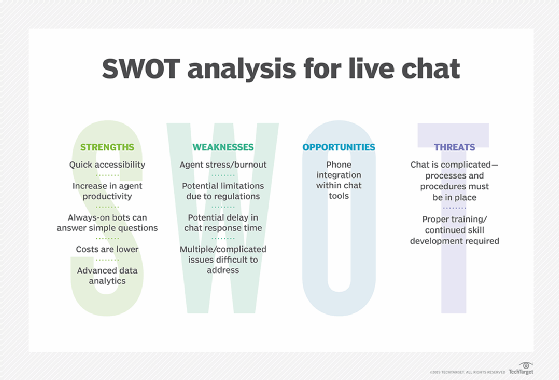live chat (live support)
What is live chat (live support)?
Live chat (live support) is technology that provides companies with a way to interact with users when they visit an organization's media properties. Live chat is typically implemented through code that is inserted on selected pages of a website, and organizations can decide on which pages to make live chat available.
How does live chat work?
Visitors can initiate a chat session by simply typing a message in the chat window. Behind the scenes, live chat may be staffed by representatives of the organization or by chatbot software that uses robotic process automation technology to automate answers to a pre-selected number of common visitor queries.
If the vendor's live chat is integrated with the organization's customer relationship management systems, the live representative can look up user details and to save the transcript to the customer's customer experience record.
Who uses live chat technology?
Live chat is used by sales, marketing and customer support staff to answer questions from customers and prospects. On the consumer side, live chat is used by visitors to seek assistance during their website sessions.
Live chat can be provided through in-house commercial software products or application program interface calls to a third-party software-as-a-service provider. Some live chat software uses artificial intelligence (AI) to automate interactions between a user and the brand. Often referred to as smart chatbots, this type of AI software uses natural language processing to understand users' requests and respond accordingly.
When users can't tell that there isn't a human being on the other end, the chatbot support can be said to have passed the Turing Test.

Benefits of live chat
Live chat can be used as both a customer service and marketing channel for organizations. Here are the main benefits of live chat:
- Is easy to read. The chats look similar to instant messaging conversations, as the text-based messages are transmitted back and forth in a chat window, usually without images, audio or video.
- Offers real-time customer service. An example of the customer service use case is an airline website. On the flight status page, a customer could chat with an airline representative to ask for further details about a flight delay.
- Helps marketers turn prospects into customers. Live chat can also be used by marketers to qualify prospects or move users along the sales funnel. For example, a hardware manufacturer could use live chat on a product pricing page to invite visitors to ask product-related questions, or a hotel website could use live chat to help users book a room.
- Streamlines communication between customer and organization. For many users, live chat is considered a more efficient and expedient customer service channel compared to a phone call. Users don't have to navigate through phone menus or be placed on hold. Instead, they can exchange short messages with a company representative. Users can visit other webpages or check email as they await answers or resolution from the representative.
- Offers customer support at a lower cost. From the perspective of the live chat provider (i.e., the organization), live chat can provide a form of customer support that costs less than phone-based support. In addition, live chat can enable sales and marketing personnel to engage with prospects and move them closer to a purchasing decision.
Editor's note: This article was written in 2019. TechTarget editors revised it in 2023 to improve the reader experience.






